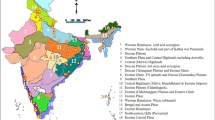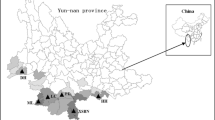Abstract
Centella asiatica is an important plant species used in traditional Chinese medicine. To help the efficient use and conservation of this species, the genetic diversity of C. asiatica populations in China was investigated using inter-simple sequence repeat (ISSR) markers. Fourteen natural populations comprising 162 individuals were included to estimate genetic diversity. At the species level, genetic diversity was relatively high (P = 66.33%, H = 0.2183, I = 0.3305). At the population level, the genetic diversity of JH (Jinhua, Zhejiang Province, China) and JJ (Jiujiang, Jiangxi Province, China) populations was relatively high (P = 43.88%, 38.78%, H = 0.1610, 0.1301, I = 0.2376, 0.1957, respectively), whereas the genetic diversity of GA (Guang’an, Sichuan Province, China) and EM (E’mei, Sichuan Province, China) was relatively low (P = 10.2%, 5.1%, H = 0.0383, 0.0211, I = 0.0570, 0.0309, respectively). On the basis of Nei’s G st value, more genetic differentiation among populations was determined (G st = 0.6573). In addition, the 14 populations were clustered into four groups in view of abundant ISSR data, which further defined the genetic relationship among populations. Interestingly, the genetic clustering result was similar to previous chemical clustering results based on high-performance liquid chromatography (HPLC) data, which would also classify the 14 populations into four groups. Thus, we combined the clustering results and compared their difference. The combined analysis and genetic diversity data provide a scientific basis for conserving populations of relatively high genetic diversity such as JH and JJ populations and establishing good agricultural practices (GAP) for C. asiatica.



Similar content being viewed by others
References
Zhou SB, Zhu SD, Yu DQ, Wang DH, Liu WJ (1998) New resources of lawn-Centella asiatica (L.) Urban. Plants 2:19
Zhao Y (2003) New resources of lawn-Centella asiatica (L.) urban. Yunnan Agric 9:15
Xu H (2005) Biological characteristics and useful value of Centella asiatica (L.) Urban. Spec Econ Anim Plant 8(8):24–25
Brinkhaus B, Lindner M, Schuppan D, Hahn EG (2000) Chemical, pharmacological and clinical profile of the East Asian medical plant Centella asiatica. Phytomedicine 7(5):427–448
Chen SW, Wang WJ, Li WJ, Wang R, Li YL, Huang YN, Liang X (2006) Anxiolytic-like effect of asiaticoside in mice. Pharmacol Biochem Behav 85:339–344
Wijeweera P, Arnason JT, Koszycki D, Merali Z (2006) Evaluation of anxiolytic properties of Gotukola—(Centella asiatica) extracts and asiaticoside in rat behavioral models. Phytomedicine 13:668–676
Zheng CJ, Qin LP (2007) Chemical components of Centella asiatica and their bioactivities. Chin J Integr Med 5(3):348–351
Zietkiewicz E, Rafalski A, Labuda D (1994) Genome fingerprinting by simple sequence repeat (ISSR)-anchored polymerase chain reaction amplification. Genomics 20:176–183
Nagaoka T, Ogihara Y (1997) Applicability of inter-simple sequence repeat polymorphism in wheat for use as DNA markers in comparison to RFLP and RAPD markers. Theor Appl Genet 93:133–139
Esselman EJ, Jianqiang L, Crawford DJ, Winduss JL, Wolfe AD (1999) Clonal diversity in the rare Calamagrostis porteri ssp. Insperata (Poaceae): comparative results for allozymes and random amplified polymorphic DNA (RAPD) and inter simple sequence repeat (ISSR) markers. Mol Ecol 8:443–451
Esayas A, Endashaw B, Tomas B (2005) Inter-simple sequence repeat (ISSR) variation in forest coffee trees (Coffea arabica L.) populations from Ethiopia. Genetica 124:213–221
Lu Z, Wang Y, Peng Y, Korpelainen H, Li C (2006) Genetic diversity of populus cathayana Rehd populations in southwestern China revealed by ISSR markers. Plant Sci 170:407–412
Sharma J, George S, Pandey M, Norcini J, Perez H (2011) Genetic differentiation in natural populations of a keystone bunchgrass (Aristida stricta) across its native range. Genetica 139:261–271
Wolfe AD, Liston A (1998) Contributions of PCR-based methods to plant systematics and evolutionary biology. In: Soltis PS, Doyle JJ (eds) Molecular systematics of plants. II. DNA sequencing. Chapman and Hall, New York, pp 43–86
Carvalho A, Matos M, Lima-Brito J, Guedes-Pinto H, Benito C (2005) DNA fingerprint of F1 interspecific hybrids from the triticeae tribe using ISSRs. Euphytica 143:93–99
Luan S, Chiang TY, Gong X (2006) High genetic diversity vs low genetic differentiation in Nouelia insignis (Asteraceae), a narrowly distributed and endemic species in China, revealed by ISSR fingerprinting. Ann Bot 98:583–589
Jin Y, He TH, Lu BR (2006) Genetic spatial clustering: significant implications for conservation of wild soybean (Glycine soja: Fabaceae). Genetica 128:41–49
Zhao Y, Chen XY, Wang XR, Pian RQ (2007) ISSR analysis of genetic diversity among Lespedeza bicolor populations. J Plant Genet Resour 2:195–199
Li HS, Chen GZ (2009) Genetic variation within the endangered mangrove species Sonneratia paracaseolaris (Sonneratiaceae) in China detected by inter-simple sequence repeats analysis. Biochem Syst Ecol 37(4):260–265
Hu Y, Zhang QY, Xin HL, Qin LP, Lu BR, Rahman K, Zheng HC (2007) Association between chemical and genetic variation of Vitex rotundifolia populations from different locations in China: its implication for quality control of medicinal plants. Biomed Chromatogr 21(9):967–975
Han T, Hu Y, Zhou SY, Li HL, Zhang QY, Zhang H, Huang BK, Rahman K, Zheng HC, Qin LP (2008) Correlation between the genetic diversity and variation of total phenolic acids contents in Fructus Xanthii from different populations in China. Biomed Chromatogr 5:478–486
Thul ST, Srivastava AK, Singh SC, Shanker K (2011) Genetic and chemical diversity of high mucilaginous plants of Sida complex by ISSR markers and chemical fingerprinting. Mol Biotechnol. doi:10.1007/s12033-011-9380-z
Doyle JJ, Doyle JL (1987) A rapid DNA isolation procedure for small quantities of fresh leaf tissue. Photochem Bull 19:11–15
Yeh FC, Yang RC, Boyle T (1997) POPGENE, version 1.32 edn. Software Microsoft Window-Based Freeware for Population Genetic Analysis
Nei M (1978) Estimation of average heterozygosity and genetic distance from a small number of individuals. Genetics 89:583–590
Rohlf FJ (1997) NTSYS-Pc: numerical taxonomy and multivariate analysis system, version 2.02a. Exeter Software, New York
Zhang XG, Han T, Zhang QY, Zhang H, Huang BK, Xu LL, Qin LP (2009) Chemical fingerprinting and hierarchical clustering analysis of Centella asiatica from different locations in China. Chromatographia 69:51–57
Hamrick JL, Godt MJW (1990) Allozyme diversity in plant species. In: Brown AHD, Clegg MT, Kahler AL, Weir BS (eds) Plant population genetics, breeding and genetic resources. Sinauer, Sunderland, pp 43–63
Acknowledgments
This research was supported by National Natural Science Foundation of China (No. 30572327).
Author information
Authors and Affiliations
Corresponding author
Additional information
X.-G. Zhang and T. Han contributed equally to this work, and both should be considered as first author.
Rights and permissions
About this article
Cite this article
Zhang, XG., Han, T., He, ZG. et al. Genetic diversity of Centella asiatica in China analyzed by inter-simple sequence repeat (ISSR) markers: combination analysis with chemical diversity. J Nat Med 66, 241–247 (2012). https://doi.org/10.1007/s11418-011-0572-4
Received:
Accepted:
Published:
Issue Date:
DOI: https://doi.org/10.1007/s11418-011-0572-4




